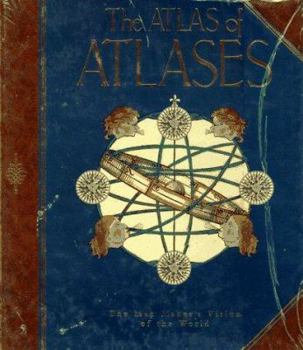The Atlas of Atlases: The Map Maker's Vision of the World
Select Format
Select Condition 
Book Overview
A distinguished collection of some of the most stunning and important maps from five centuries of atlases. From the anonymous early atlases of the 15th-century to works by all the great cartographers,... This description may be from another edition of this product.
Format:Hardcover
Language:English
ISBN:0810939185
ISBN13:9780810939189
Release Date:January 1992
Publisher:ABRAMS
Length:160 Pages
Weight:2.95 lbs.
Dimensions:0.8" x 10.8" x 12.4"
Customer Reviews
2 ratings
A Vision of the World by Medieval Europe
Published by Thriftbooks.com User , 16 years ago
''Men in Seville, Amsterdam or London had access to knowledge of Mexico, India, Canada or Brazil, while the native peoples knew only their own immediate environment.'' Peter Whitfield Atlas Visionaries: If you, like my namesake Cosmas Indicopleustes, who loved to write about his exploration and discoveries, have an interest in cartography, its history or at least, enjoy looking at maps, or review atlases, this is then your book. The Maps and illustrations are stunning, the text is reader friendly and informative. Not a dull moment, that you are to encounter throughout. This Atlas is truly the one atlas, mother of first printed atlases, tracing their history from the Ptolemy's 1482 Cosmographia to the The Times Atlas of 1897. Brief History of Cartography: Strabo, writing in Alexandria in 20-10 BC, tells us that the first map of the world was compiled by Anaximander of Miletus in the early part of the sixth century BC, followed soon after by a treatise on geography, including a map showing the earth as a plane or disc by Recataeus. They believed in the Homeric theory of a disc-shaped world surrounded by the great river Okeanus with Delphi and the Aegean at the center of the inhabited world. Others, however, leaned to the Pythagorean theory of a spherical world, a theme taken up by Plato, Herodotus and Aristotle, which gradually came to be accepted throughout the Mediterranean world. Strabo's mis-interpretation of the rival calculations of the circumference of the world made by Eratosthenes and Posidonius was accepted a century later by Claudius Ptolemy who consequently presented a distorted view of the world which dominated geographical thought until the sixteenth century. Ptolemy's Geographia: Ptolemy's, a mathematician, astronomer and geographer, living in Alexandria, assembled and systematized his forerunners' cartographic theories especially those of Marinus of Tyre (Ca AD 120) to whom he was indebted. About AD 150 he published his Geographia, a work in 8 volumes, illustrated with a world map, few regional maps and a great deal of smaller maps. Although the text of 'Geographia' survived, no original maps (older than the twelfth century) have come down to us and consequently, we have no means of knowing whether the 'Ptolemy' maps on which we set so much store were, in fact, drawn by him or were the interpretations of later map makers using his textual description. Later, Cosmas Indicopleustus, explorer and cartographer, in his Christian Topography (written 547-549) insisted on verifying, by reference to numerous scriptural passages, the flatness of the earth. Medieval Cartography in East & West: Richard Bernstein Declares, in a review, "One of the differences between the West and other parts of the world, and one of the reasons for the global spread of Western power, is that Europeans inscribed their knowledge on maps while others didn't." This was not always the case, earlier, in mediaeval Alexandria, to close with the work of P
Pleasant 'coffee table book' on cartography
Published by Thriftbooks.com User , 18 years ago
This pleasant casual book on cartography is richly illustrated. Particulary appealing are the reporductions of the atlas maps in situ, with the atlas open to the map and the other pages and edges of the cover visible. Along similar lines, several closed atlases are pictured allowing one to view the cover and clasps. Also interspersed throughout this text are cartouches and title pages. I would not consider this an authoritative review of cartography. For example the maps illustrated from the monunmental 1513 Waldseemeuller Geography include two maps of Africa, and a map of Crete, hardly considered among the most influential maps from that Atlas. Nonetheless, this is a pleasurable book, richly illustrated, with an emphasis on the visual not written experience. Note that this book was reprinted in the U.S. in 2000, with the title "Mapmaker's Art", a more appropriate title given the book's emphasis.






